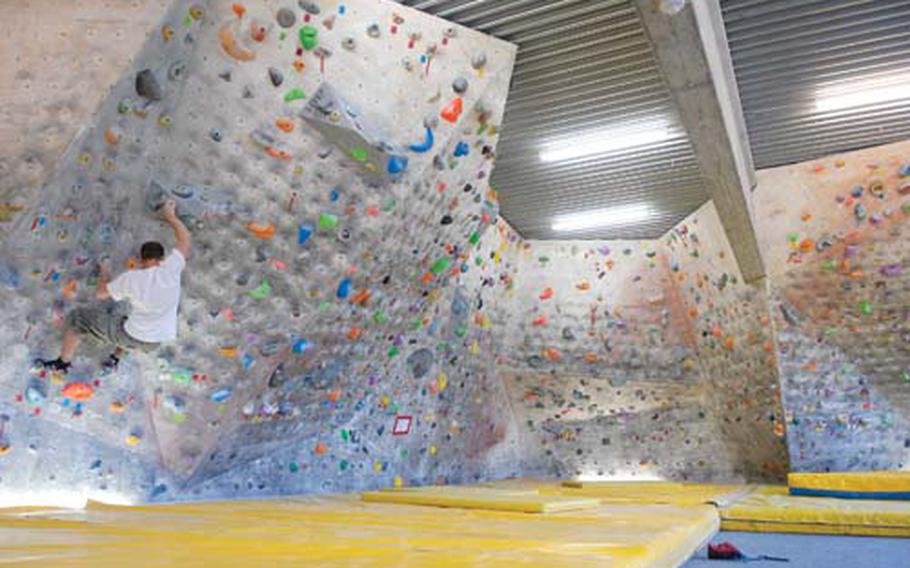
A climber makes his way around a bouldering room at the Extreme Climbing Center in Ludwigshafen. The room covers 3,000 square feet of fake caves and cliffs that climbers can tackle without ropes (Ben Bloker / S&S)
The mind-numbing monotony of repetitious exercises doesn’t do much to sell the benefits of a gym membership. Bar goes up. Bar goes down. Bar goes up. Bar goes down. After a few months of that, even NASCAR doesn’t seem so tedious.
But let’s face it, that extra junk in your trunk isn’t going away just because you made a New Year’s resolution to lose a few pounds.
So what are you supposed to do?
Well, gyms aren’t always so blah.
Consider Das Kletterzentrum Extrem — or Extreme Climbing Center — in Ludwigshafen, Germany. Don’t let the name fool you; it is a gym. To be more precise, it’s a warehouse-size climbing gym.
What it does is replicate the experience of scaling the side of a cliff in good weather (it’s much more dangerous — even impossible — to climb some mountains when the weather isn’t good). It does for climbing what indoor skate parks do for skateboarding; that is, it brings an extreme sport inside so you can do it without waiting for the rain to stop or summer to start.
The climbing center in Ludwigshafen has more than 200 marked and unmarked routes along its main, 20,000-square-foot climbing hall. Some of the holds climbers are expected to grip on their way to the top aren’t much bigger than a big wad of used gum. Others are easily as big as softballs.
The center’s vertiginous paths range in difficulty from 2 (not much harder than climbing a ladder) to 9+ (about as easy as swimming to the moon) on the difficulty scale. For these, even the most experienced climbers have to be roped in to avoid the risk of taking a 30-foot header onto the floor.
Thanks to the ropes, though, the worst threat to most climbers — at least those experienced enough to climb out on an overhang — is the pendulum-like swing and painful crunch into the wall after losing a grip on the ceiling (which photographer Ben Bloker and I watched happen. The climber bounced, apparently unscathed).
If being strapped in isn’t your thing, there’s also a bouldering room where climbers can traverse across an additional 3,000 square feet of faux caves and cliffs without ropes but with thick mats to cushion the inevitable fall.
It might not sound like the optimal way to concentrate and cast off stress, but those who have felt the acid burn in their forearms and calves on a tricky ascent say differently.
Climbing, said Christian Stolina, a Ludwigshafen local and three-year member of the center, is “a very spiritual thing.”
Stolina started climbing in 2006 after a job-related climb to the top of a tall tower revealed to him an almost overwhelming fear of heights.
“That’s why I started climbing,” he said. “I was afraid of it.”
Most of the year, though, he’s outside. He climbs in the center during the winter to get better for the next outdoor season, he said.
“It’s really more for getting power and training on your climbing techniques,” he said.
And, of course, having a good time while doing it.
Directions: Ludswigshafen is on the west side of the Rhine, just over the river from Mannheim. To get there from east or west, take Autobahn 6 toward Mannheim. At Kreuz Frankenthal (on the west side of the Rhine), take exit 21 to merge onto A61 toward Karlsruhe/Neustadt/Weinstrasse/Ludwigshafen. Take Exit 60, Kreuz Ludwigshafen, and merge onto the A650 toward Ludwigshafen, then take Exit 8, Ludwigshafen Oggersheim-Sud, toward LU Friesenheim. Turn right at K3 (following signs for Friesenheim) and then another right onto Mannheimer Strasse. About a mile down the road, take a left onto Saarburger Strasse and follow it around the curve. The climbing center will be on your right.
Times: The center is open 10 a.m. to 11 p.m. Monday through Friday, 10 a.m. to 9 p.m. Saturdays, Sundays and holidays.
Costs: A one-day pass for the whole center costs 13 euros for adults, 11 euros for students (with ID) and 8 euros for youths 5 to 13 years old. For those wanting to stick to the bouldering room, it’s just 8 euros a day. Newcomers can rent shoes, a harness, chalk bag, belay device and a carabiner for 7 euros (shoes — at 3.50 euros — are the only real necessity in the bouldering room). Group rates, memberships and family discounts are also available. Beginners can take two, three-hour lessons for 69 euros.
Food: Energy drinks, water and beer at standard prices.
Information: The center’s Web site, www.kletterzentrum.de, is in German. Some of the staff members speak English; call them at 0621-528-374.